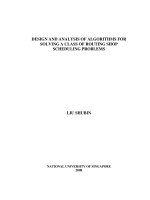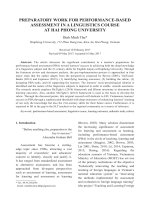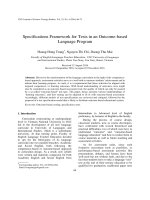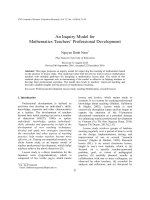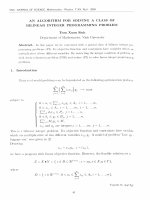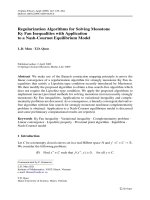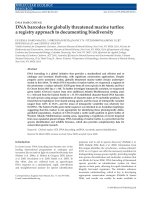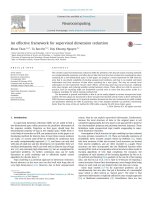DSpace at VNU: An algorithm for solving a class of bilinear integer programming problem
Bạn đang xem bản rút gọn của tài liệu. Xem và tải ngay bản đầy đủ của tài liệu tại đây (2.02 MB, 7 trang )
VNU
T.xx, N()4 - 2004
J O U R N A L O F S C I E N C E , M athem atics - Physics.
AN
A L G O R IT H M
B IL IN E A R
FOR
IN T E G E R
SO L V IN G
A
CLASS
P R O G R A M M IN G
OF
PROBLEM
T ra n X u a n Sinh
D epartm ent o f M athema tics, Vinh University
A b stra ct.
In this paper we be concerned with a special class of bilinear integer PH.
gram ini rig problems (PI)- Its objective function and constraints have variables which <\1 ‘
m ultiplicative of two different variables. By restricting the integer condition of problem w*
shall stu dy relaxation problem (P IR ) and reduce (PI) to solve linear integer program m er
problems.
1.
Introduction
Many real-world p ro b lem s call be formulat('(l as th e following o p tim iz a tio n problem
J2(H,CiXii)yj
j= \
max
2=1
subject to
' 0 < (Ii ^ J2 ]l=1
0 ^ '1'ij ^
Xij-Ijj
< Ai, 1 = 1 , . . . , m ,
J I'
J
•••J
!>•••)
E i = i diXij < p j> 3 =
0 ^ bj ^ (Jj ^ B j , j = 1 , . . . , n,
K
X ij
an d ijj are integers, i = 1 , . . . , m;
j = 1 , . . . , 71.
This is a bilinear integer problem. Its objective function and constraints have va;icl)le
which are m u ltip lic a tiv e o f tw o different variables X i j , Ljj. A m odel o f problem : Lille IỊ) ;
luggage van" was given ill [2 ].
Denoting
Zj j = X i j j j j ,
z =
5
W(' have a p rogram w ith linear o b je c tiv e function. However, th e feasible solu tion set. is
Z = X * Y = { z e D c R n+m :z = x y , x e x , y e Y},
where
D = { 2
€ R n+m : 0 < (li
Á " L = l ' ■■
3= 1
T y p eset by .ẠyVỊcST^ỳ
41
T ra n X u a n S in h
4»
x=[
fc R " + "' : 0 < x ij
1 , . . . , m; j = 1 ,.. ■,n ; y
djXij ^ Pj ,7 = 1 ,...,/» } .
1= 1
y
= {
y € R n : 0 ^ bj sC Vj <: D j , j = l , . . . , n , J 2 M j V j ^ M ) .
j= 1
Ii this paper we restrict the integer condition of problem and reduce to the following
(pimzition problem (PI)
(1 )
(PI) m in c r z
ailjet o
z
Z j — Xj i j j , J =
X
€ D
1, 2, . . .
(2)
,p
(3)
€ x,y e Y
(4)
z integer,
vbrc
(5)
V
c =
(Cji ) , CT Z
=
3=1
V
) = { 2 € w • ^ ^ ftij Zj ^
j=
Ỉ = {x € W
1 1 — 1 , . . . , ĩíì, Ị 0
Zj ^
5 j , j = ]u
• • • >/-*} Ị
(6)
1
: 0 < (Lj ^ X j ^ A j , j = 1
(7)
p
' = { y e R '' :
wtbu loss of generality
wjhutin-eger constraints
= a<,i = l , . . . , ợ ; 0 ^
bj
^ Vj ^ £ y,. 7 =
1,...,/)}.
(8)
assume th a t Pi are integers and
A > 0. The problem,
of 2 ,was studied by T.v. Thieu [4j. In this paper, we
arc goi
tobffifip an adjacent different method to transfer problem (PI) to the linear integer
Mgnnmng problems.
D ace
Ự = {] ■(*ij > 0 , i = 1 , . . . , q; j = 1 , . . . , /;};
K = {j ■a i) < 0 ,'t = 1 , ----- q-,j = 1 ,. ..,])}.
Fill (3, J)i x j > 0 we infer th a t tjj = — . We can write the constraints ( 8) as
Xj
A n a lg o rith m f o r s o lv in g a c la s s o f b ilin e a r i n te g e r p r o g r a m m i n g prolien
3
Define
Uj = ^
Xj
t tj = (Uj) e I V ,
(!)
where tij satisfy the constraints
{oLij/Aj) ÍỈ tij ^ {atij/cLj), for all j € I ị ,
(otij/dj) ^
tij ^
(otij/Aj),
for all
j
1 ()
G I~ ■
Tj = {tj e W 1 : tij satisfy (10)}.
Choose X* e [cLj, A j ] , j = 1 , . . . ,p. From (9) we have
t ; = (t* j) = ( a i j / X j ) .
Without any integer constraints (5), we have relaxation problems (PIR)
(PIR)
( 1)
inin CT Z
subject to
z £ D,
zj
jUj 1J
X
2
1 Ị 2 , . . . , p,
(E
X ,y
G
3
4
Y,
As usual a triple (x , y , z ) w h o s e en tries satisfy (2 ), (3) and (4) is called a ftOiiUesouioi
of (PIH), a feasible solution achieving the minimum of ( 1 ) is called an optimalHOtiio.o'
(HR).
C h oo se X* =
= (t*j) = ( ot i j / x*) , we so lv in g linear programming
' m in e 2
(LPl)
subject to
H d
, S j = l ^ljZj = a i ->1 =
(1
• • • >9*
Let z* = (z*) be a basic optimal solution of the linear problem (LP1). By B VC teioe h(
basic associated with z* and J the index set of B. From ;r* and z* we have I* = 2^ )
So,
is a feasible solution of problem (PIR). Denote
= ( c j),jG J
T ran X u an S i n k
I Main r e s u l t s
Let (x*, y*, z*} be a feasible solution of (PIR). I f it satisfies the con-
proposition 1.
prints
C B B - h j ^ C j , t j € T j , f o r all j =
(12)
tho X f , z * ) JS an o p t im a l s o lu tio n o f ( P i n ) .
?roj \ssume to the contrary that there exists a feasib le solution (.x , y , z ) of (PIR) which
ii lettff than ( x*, y*, z*) , i.e. such that
CTZ ^ CTZ*.
Jicei = (tij) — (a i j / x j ) £ Tj and constraints ( 12 ) we have
c b B ~ 1ỉj ^ Cj , for all j = 1 , . . . , p.
,v ltì'6 : = z * , u = 0, (z*, 0) which is an optimal solution of problem
min CTZ
(LP2) <
-
subject to
(13)
zeD
2 j = i t*jz j
£ j = i t ‘j u j =
* =
! >• • • »
Orurvisi, with z = Q,u = z, (0,z) is a feasible solution of (LP2), with
CTZ > CTz*.
Hn
-CTz .
riis shows th a t ( x*, y*, z*) is an optimal solution of (PIR).
I m a r k 1 . To verity constraints (12), for every j = 1 ,2 ,.. .,/ ; , we can to solve
pjben
r max(c.BB ~ 1 tj)
(LP3)< subject to
1 tj € Tj
ad oikfo: Ml o p tim a l solu tion t j = (t[j ). If (c b B ~ 1t j ) ^ Cj, for every j = 1 , . . .
,p, then
casráKS (]2) are satisfied.
n ;)ỊO íe
f £T
Sici
now th a t (x*,y*, z*) d oes not satisfy th e con strain ts (12), i. e. there exists
hat
cB B ~ l tk > ck .
( 14 )
A n a lg o rith m f o r so lv in g a class o f bilinear in te g e r p r o g r a m m i n g
p
r o
b
l i T
5
t
Consider the linear program
min(c r 2 +
Ck Vk )
subject to
(LP4) < E j = i tijZj + f'kv k = « i , * = ! , . • • , q
J2j =l Pijzj + PikVk ^ Pi, i = 1 • • • . m
k 0 ^ z j ^ Ốj , J
1 , . . . , p,
(15
Vk ^ 0 ,
where Vk is a nonnegative variable.
Assume that (LP4) has an optimal solution (z , v k).
Denote
,
,
zk + vfc>if j = k
z âj, if j = 1 ,... ,p, Í Ỷ k and zk + vk
Zj = {
0
(6
2 *, if j = 1 , . . . , p , j Í k and z* + Vfc = 0
and
' t j , if j Í k, j = 1 , . . . ,p
i'., if j = fc, 4 + w* = 0
tj =
(7
Zkt*k + UT^-, j = K zk + vk ^ 0.
+ ufc
I f there exists an index
satisfying (14), th e’ n (x *,y*,ĩ*ì -HI
&Í )(
changed to a new feasible solution (x , y , z ) of the problem (PIR) which is eit.h'i b>t (‘2
P r o p o s it i o n 2.
k
than (x*,y*,z*).
Proof. From z * , z , v k and applying (16), (17) wc have Z j , t j , (j = 1
A
the convex set, t j
€ T j.
She r ?iis
then we get
r , *
+ t k ( z k + v Ar)
j=l
If Zfc 4- Vfc = 0, then
p
A
p
t j Zj = y t*z* = a (because
j=i
j=1
= 0 for k ị J ) , where a =
If Zfc + Vfc ^ 0, then
= Ỳ . tJ Zl + V kt 't = a -
j= 1
(oti)
T r a n X u a n S in h
&
'N t
have
V
V
j=ij^k
j= i
p
Y A
P j )I1
jz;
< Pi (because j Ệ J ) , if z ị = 0.
(16) we have
V
j = l
It fellows that
V
3=1
_ 1 Pi j Zj ^ iiL. (see (15)). It is easy to see th a t Zj > 0. From t J and (9)
w! fnd X and z. from (3) find y. This shows that ( x , y , z ) is a feasible solution of (PIR).
It is easily verified that (£*,()) is a feasible solution of (LP4), but from (14) then (-*,()) is
nit m optimal solution of (LP4). It follows th a t CT Z* > cTz + ckvk = cTzj i i. (\ (x y z)
isbitti'r than (./•*,;;
Before presenting the algorithm, we have some remarks.
R e m a r k 2. Relaxation problems (PIR) haven't integer constraints. Since D is a
pihhcdron, using the Goinory cut method (or the coordinate cut [1 ]) for solving linear
ir;ejer programming, it follows th a t after a finite number of steps we rec eive an optimal
iitejer solution.
R e m a r k 3. Sinco D is a polyhedron, using methods of linear programming. after
afiiite number o f stops we receive ail o p tim a l s o lu tio n o f program (L P 1 ).
4. The solving (LP3) is ail easy task because Tj, for
jcarectangle (from ( 10)).
R e m a rk
( 'V e ry Ì
— 1,2
R e m a r k 5. (LP4) and (L P l) (lifter from one to another only by a now column.
Jei;:e,
solve (LP4) we call 1ISO the solution of (LP1). Applying the reoptimization
tcluique of linear programming, we have the solution of (LP4).
.. The a lg o r i t h m for s o lv in g p r o b l e m ( P I )
From the above results we are now ill a position to derive an algorithm for solving
Ị ()>1(11 (PI)- The algorithm consists of the following steps.
Step 1. Take X* E X . determine tj 6 Tj from (9), (10). Solve the linear program
(Jl). w
!>(' a basic: optimal solution, with basic D and the index set J of D.
> ep 2 . I or every j = 1 , 2 , . . . , p, we solve the linear program (LP3) and obtaining
•1 ,|> inil sc-huion tj = (tjj).
A n a lg o r ith m f o r s o lv in g a c la ss o f b ilin e a r i n te g e r p r o g r a m m in g p r o b le m
4'
If ( c s B ~ 1 tJ) ^ Cj, with j — 1 , . . . t hen (z* ,'£*) is an optimal solution of r >lix
ation problems (PIR ). Go to Step 4.
Otherwise, there exists a first index k satisfy (cj3-B_ 1 ^/c) > Cfc- Go to Step 3.
Step 3. Solve the linear program (LP4), let (z , vk ) be ail optimal solution. Iron
(1G) and (17) we ch a n g e to a n e w feasible so lu tio n (x, y, z) w h ich is b e tte r than ( x* y y* z*)
Go to Step 1.
Step 4 • If
is integer then (x*, y*, z*) is an optimal solution of (PI). Othorvke
to acid a cut constraint and go to Steps 1.
P r o p o s i t i o n 3.
The above algorithm terminates a fter a finite number o f steps.
Proof From remarks 1, 2, 3, 4, 5 we have the proposition.
R e fe re n c e s
1. Nguyen Ngoc Chu, The coordinate cut for solving discrete programming probicn
Preprint, Institute o f Mathematics, Hanoi, No. 24(1983).
2. Tran Xuan Sinh, An algorithm for .solving the integer programming problems vih
the special structure, The sum m ary record of a conference ”A P P LIE D MATHE
M A T I C S ”, the whole country, first time, Hanoi, 23-25/12/1999, Publishing h)Uie
National University Hanoi, T.II, 2000, 551-556.
3. Tran Xuan Sinh- Bui T he Tam, Some m atters when finding the solution of a lin
ear p r o g r a m m i n g problem, Scientific Bulletin of Vinh Pedagogic University, Jog
(1997), 18 - 25.
4. Tran Vu Thieu, A note on the solution of a special class of nonconvex optimizai
